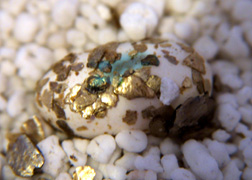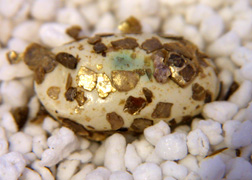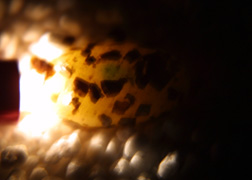

| One page Caresheet | |||||||||
| Housing | Foods | Health | Shedding | Cleaning | Breeding | Genetics | Care sheet | ||
Breeding and Incubating
Realities
The breeding of Leopard Geckos is relatively easy, before you begin to breed them however I must stress that the decision to breed your leo's or not should not be taken lightly. Ask yourself the following questions.
- Do I have the time and money available to keep gravid females in the best of health?
- Do I have the equipment needed to incubate the eggs?
- Do I have the free time available that will be needed to care for the hatchlings?
- Do I have an outlet for the offspring, or am I willing to keep all hatchlings?
If you can honestly answer yes to all of the above questions then you may find the following sections interesting and informative.
What do you need for breeding
The basics that you will need to think about before you start breeding are listed blow.
- You need at least one male and one female leopard gecko.
Your Leos should be around a year old and weigh at least 45 grams before you start your breeding program. - Somewhere to incubate the eggs.
You can use a home made incubator, a commercial one such as a hovabator or incubate the eggs inside the vivarium in a sealed box. - Somewhere to house the hatchlings
Small plastic containers measuring around 8 x 4 inch are ideal for housing hatchlings singularly. - Somewhere to house the hatchlings once they have grown on.
Plastic contico boxes measuring around 8 x 11 inch are very good for housing leopard geckos you are growing on.
Mating
Once you have the Leopard geckos that are sexually mature and in good health it's time to look into the possibility of mating them. The breeding season for Leos runs from February to September, although you can mate them out of season it is advised to follow their natural breeding season as much as possible. It is also worth mentioning very young or underweight female leos can sometimes be mated successfully but may not produce viable eggs, or will only produce the odd one or two eggs. If you are attempting to mate young/underweight leos I must also point out that this can cause stress and lead to the premature death to your breeders.
Conditioning
Some breeders condition their animals before mating, the photoperiod is reduced down to 6-10 hours, the temperature in the vivariums is reduced by 10-15 degrees Fahrenheit and the amount of available food is reduced. Conditioning is usually done from late November to early January and usually lasts about 8 weeks. After this period of time the photoperiod, temperatures and available food is slowly returned to normal levels.
Breeding introduction technique
There are two main ways that people house their breeder geckos,
- The first is the harem method where one male is housed with two or more females. This method lends itself well to commercial breeding on a large scale or for those with limited space for their leopard gecko collection.
- The second is where all males are kept separately and the females are introduced to them. This second method is useful for selective breeding, keeping more accurate parental records or preventing early breeding.
Egg Laying
In the weeks following the introduction you will notice the female putting on weight around the abdomen, if you were to turn her over at this point you may notice the outline of her eggs through her abdominal skin. The development time for the eggs varies between females, anything from 2-5 weeks is common. When the female is about to lay she will get restless and wonder around her enclosure and occasionally dig in the substrate. Some females will also eat less, or nothing at all, as the time to lay approaches. On the day that she actually lays she will almost probably re-arrange her enclosure. Once you notice the females looking restless you should introduce a laying box to the vivarium, laying boxes can easily be made from small containers measuring about 8L x 4W x 2H inch filled with moist moss, perlite or vermiculite.
|
|
||||||||
|
|
Incubating
A Leopard Geckos sex is temperature determined. This means that you can determine what sex your hatchlings will be by incubating at a specific temperature. Incubating at 85 degrees Fahrenheit will give you a good balance of male to female hatchlings. Incubating at around 82 degrees Fahrenheit will give you mostly females and upping the incubation temperature to 88 degrees Fahrenheit will give you mostly males. It is thought that the temperature determined sex is only within the first 21 days of incubation, after this period of time the sex of the hatchling is locked in.
Hatchlings
All being well your hatchlings will hatch from the egg in the next 40-60 days after being laid. I would recommend moving them into separate containers at this point so it is easy to monitor their health and feeding.
 This is a picture of a hatchling on the day it hatched. It is about 1.5 inch long (3-4cm).
This is a picture of a hatchling on the day it hatched. It is about 1.5 inch long (3-4cm).


Copyright © Steven Kirby www.leopardgecko.co.uk 2003-2019. All Rights Reserved. Last modified 30/11/19




